The due date for filing your annual return of income for the assessment year 2017-18 is July 31, 2017. Working professionals who have yet to file their tax returns must start now. There are multiple reasons why you should file your taxes on time. Hence, you must not delay.
In the years gone by, filing taxes was a tedious affair. There used to be lots of paper work, not to mention the manual process of filling and submitting the form. Most individual either avoided the complicated process or hired the services of a tax return preparer or chartered accountant.
Today, with digitisation and the simplification of the income tax return form, you can file tax returns from the comfort of your home. e-Filing of I-T returns is a must for income above Rs 5 lakh. Salaried individuals can use the single-page income tax form for income up to Rs 50 lakh.
Every individual or HUF (Hindu Undivided Family) whose total income exceeds the maximum amount that is not taxed is obligated to furnish his/her/their return of income. Here, you need to consider the gross income, before any deductions under Chapter VI-A of the Income-Tax Act, 1961.
| Category |
Amount (in Rs) |
| Individuals below the age of 60 years |
2,50,000 |
| Individuals, being resident in India, who are of the age of 60 years or more at any time during the financial year 2016-17 |
3,00,000 |
| Individuals, being resident in India, who are of the age of 80 years or more at any time during the financial year 2016-17 |
5,00,000 |
e-Filing your returns is a simple process. There are several online-tax-preparing websites you could access, which are more user-friendly than the Income Tax e-Filing portal and provide guidance where necessary. Some charge a fee depending on the services you opt for, so make sure you review multiple websites before choosing one.
However, if you are a salaried professional with a few sources of income, filing your tax returns through the Income Tax e-Filing portal will be the best option. You can file your returns in a few simple steps. However, there are some prerequisites. These are as follows:
- Register on the https://incometaxindiaefiling.gov.in portal
- Visit - https://incometaxindiaefiling.gov.in/ on the top right-hand corner, there is an option to ‘Register Yourself’.
- Click on the button and proceed to select ‘User Type’ such as Individual, HUF, etc. and continue.
- Enter the basic particulars such as PAN, name, and date of birth. This should match with the Income Tax department’s records.
- Next, fill in a registration form that will include your Password, Personal details, Contact information, Current address, and enabling of alerts, etc.
- Once submitted, you will receive an activation link to the registered Email ID and an SMS along with OTP (One time Password) sent to the registered Mobile number. In order to activate the account, click on the Activation link and enter the Mobile PIN. For Non-Resident Indian, the Mobile PIN is exempted.
- On successful following of these steps, your user account is activated and the database is updated.
You can download this document here from the Income Tax website for more on e-Filing registration and services.
- Keep the below list of documents at hand
- ✔ Aadhaar Card or the 12-digit Aadhaar number
✔ Form 16 / Form 16 A
✔ TDS certificates / Form 26AS
✔ Interest statement showing interest paid to you throughout the year
✔ Savings certificates, insurance receipts, etc. to claim deductions
✔ Details of bank accounts in your name
✔ Balance Sheet, Profit & Loss Account Statement, and other Audit Reports wherever applicable.
(Read here on how to download and understand Form 26AS )
Once ready, there are two methods to file your returns on the portal. With the first option, you can download the applicable I-T form from the income tax website, fill the form offline, save it, generate an xml file, and upload it.
The second option that’s available is to enter data directly in an online form and submit it. This option is only available if you are filing ITR 1 or ITR 4.
| ITR |
Description |
| ITR 1 |
For Individuals having Income from Salaries, one house property, other sources (Interest etc.) and having total income upto Rs 50 lakh |
| ITR 2 |
For Individuals and HUFs not carrying out business or profession under any proprietorship |
| ITR 3 |
For individuals and HUFs having income from a proprietary business or profession |
| ITR 4 (SUGAM) |
For presumptive income from Business & Profession |
Option 1 – Filling the ITR form offline
For this option, here are your steps…
- Download the required ITR form from the income tax website
Visit https://incometaxindiaefiling.gov.in/ and download the ITR form based on your income and profession. You can download either an Excel version or Java version depending on the software you have installed on your computer. Most commonly used is the Excel form. You need to enable Macros in the excel workbook before entering data.
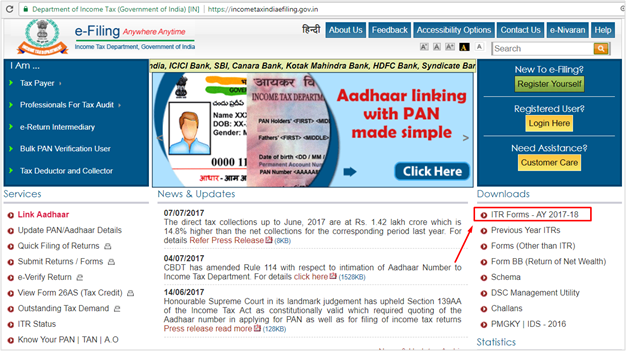
Click on the download option for the respective Income Tax Return Utility which has a list of ITR forms.

- Fill up the offline Income Tax Return form
You can only enter data in the cell highlighted in green colour. The columns labelled with red text are mandatory. You cannot use shortcut keys for cut, copy or paste in this excel workbook.
There are five sheets. After filing the form, you can validate it by clicking the ‘Validate’ button at the top right corner. If anything is amiss, you will get a popup with a list of items that need attention to.
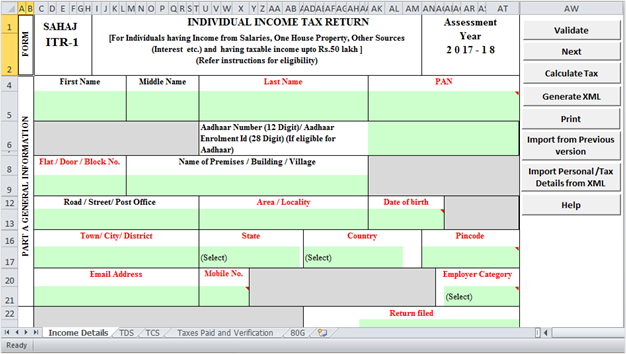
Once you have entered all your income received and deductions availed, you can click on ‘Calculate Tax’ to know the tax payable or refund, if any.
In the next two sheets, fill up the specifics of Tax Deducted at Source (TDS) and Tax Collected at Source (TCS). This information will be available in your Form 26AS and can be verified with Form 16 or Form 16A that you have received from your employer or tax deductor.
In the sheet of ‘Taxes Paid and Verification’, you will get the calculated tax payable or refund. Here you will also need to mention the specifics of the bank accounts held in your name. Along with this, you need to mention the total cash deposits in the account in the demonetisation period (November 9, 2016 to December 30, 2016), if the aggregate cash deposits exceed Rs 2 lakh.
- Generate the Income Tax Return XML
Once you have entered and validated all the information entered, you can generate and save the XML by clicking on ‘Generate XML’. You will need to upload this file on the Income Tax website and also print the form for your records.
- Upload the Income Tax Return XML
Login to your Income Tax e-Filing account (For details refer to Step 1 of the next process). After logging in, you will get the option of ‘Upload Return’ under the e-File tab.
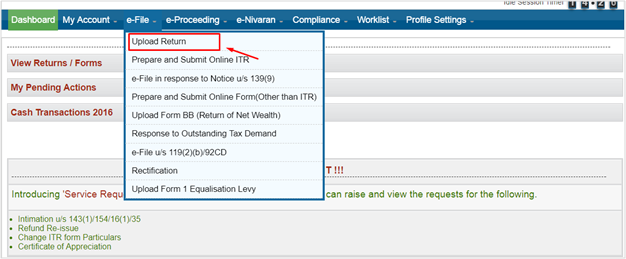
On the upload return page, select the relevant assessment year, ITR form number and attach the XML file saved in Step 3.
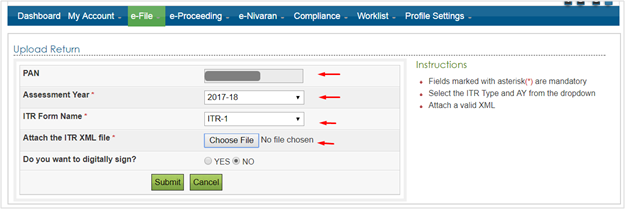
If you have a digital signature, which is registered with the e-filing website select ‘Yes’ and click ‘Submit’. Most individuals do not have a digital signature, and it is not required.
Once uploaded, you will need to e-verify your returns.
- E-Verify Income Tax Return
After successfully submitting your Income Tax Return form, you need to e-Verify your returns. This can be verified through:
- An electronic verification code (EVC) by logging in through your internet banking account; or
- Aadhaar OTP; or
- By sending the signed acknowledgement copy of the ITR to the Centralized Processing Centre (CPC), Bengaluru.
The second option is simpler and preferred, especially now since linking your Aadhaar with PAN card is mandatory.
(Read: How to link your Aadhaar with PAN in 3 easy steps)
Once verified, you will receive a confirmation message from the Income Tax department and an acknowledgement will be sent to your registered email id. With this, you complete the process of e-filing your income tax return.
Option 2 – Fill ITR form online (only for ITR-1 and ITR-4)
- Login to your Income Tax e-Filing account
To login to your account, visit https://incometaxindiaefiling.gov.in/, on the top right hand corner, you will get an option to ‘Login Here’, click on the button and proceed.
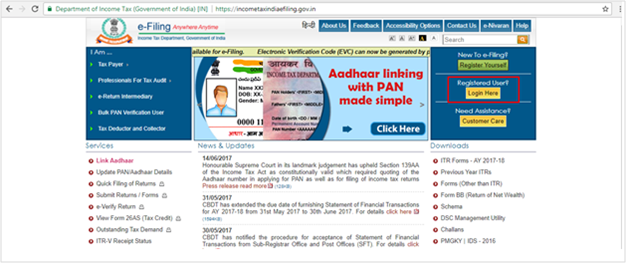
You will come to the Login Page as seen below. Enter the User ID (PAN), password, date of birth, and Captcha Code. Click ‘Login’ to gain access to your e-Filing account.
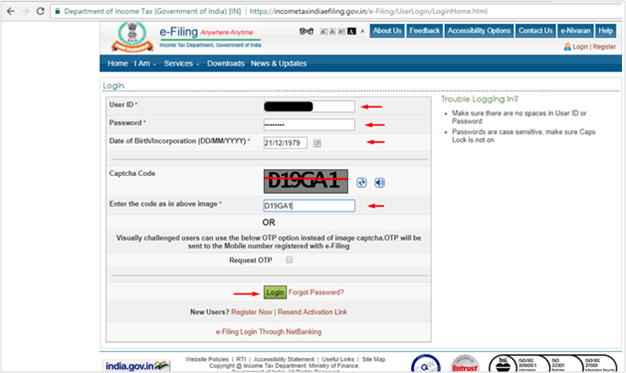
- Go to the online form
Once logged in, you will need to access the online form. Under the e-File tab, click on ‘Prepare and Submit Online ITR’.
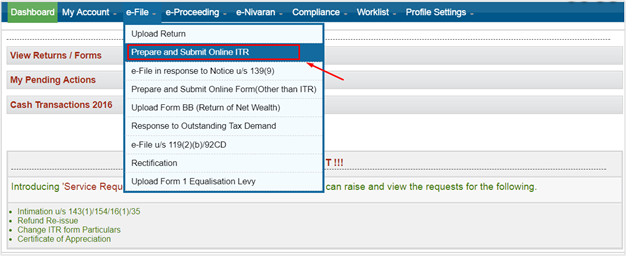
Your PAN will be prefilled. All you need to do is select the assessment year from the dropdown, the ITR form relevant to your tax status (ITR-1 or ITR-4) and select one option for prefill address. For the last option, no matter what is chosen, you can edit the address before the final submission of the form.
If you have a digital signature that is registered with the e-filing website, select ‘Yes’, and click ‘Submit’. Most salaried individuals do not have a digital signature and it is not required.
- Fill the online ITR form
Read the instructions carefully. You can download a detailed set of instructions from here. To move between the tabs, you can click on the tabs directly or on the arrow buttons available at the top and bottom of the page.
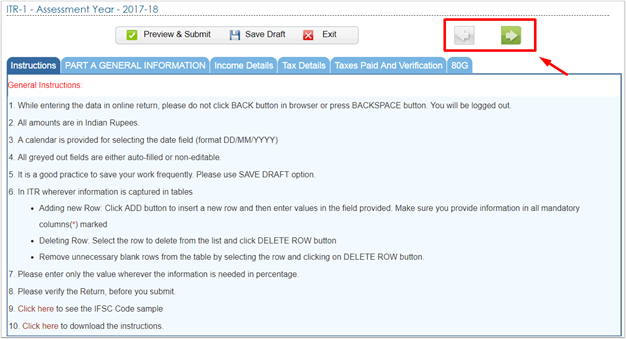
And don’t forget to click on ‘Save Draft’ to avoid being logged out. Even if you have to leave the form midway, you can do this after saving the form. When you login back to the website and access the form, the saved information will be loaded.
Part A contains all the basic particulars. If you requested to prefill a new address in Step 2, you would get a blank form as below. Enter all that is required and move on to the next tab.
On the next tab, you need to enter your income and deductions. Enter the particulars as mentioned in your Form 16 and other income in the form of interest, and/or rent income, etc.
For 80G deductions to reflect here, after entering the income, enter particulars of the donation/s on the last tab ‘80G’.
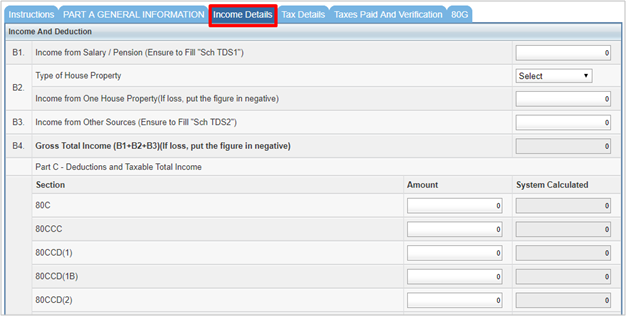
On the next tab ‘Tax Details’, you will get specifics as mentioned in Form 26AS. Verify this with the Form 26AS downloaded and your Form 16. If some information has not been captured or is incorrect, you can rectify it here.
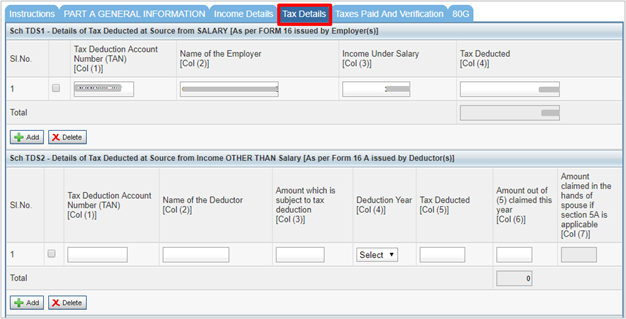
After entering the details in the above tab, the next tab i.e. ‘Taxes Paid And Verification’ will provide a summary of the tax payable or refund.
Here you will also need to mention the specifics of the bank accounts you hold. You may add or delete a bank with the Add/Delete buttons. In addition, you need to enter the amount of cash deposited during the demonetisation period (November 9, 2016 to December 30, 2016), if the total cash deposits was above Rs 2 lakh.
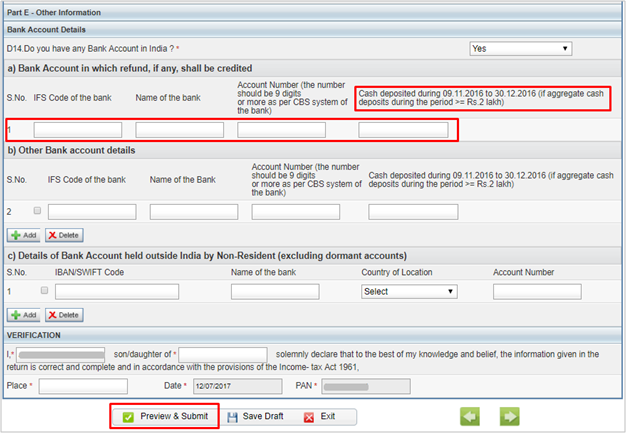
Enter details for verification and click on ‘Preview & Submit’.
In this process always click on ‘Save Draft’ to avoid being logged out. Even if you have to leave the form midway, ‘saving the draft’ can help you login back with the saved information loaded.
- Preview and Submit the form
On clicking ‘Preview & Submit’, if there are any discrepancies or if you have missed any mandatory fields, you will get a pop-up message detailing the error. Once this is rectified, you will be able to preview the entire form on one page. Make sure all the details are accurate and correct. If needed, you can edit the section where there is an error. If there are no changes, submit the form.
- E-Verify Income Tax Return
After successfully submitting your Income Tax Return form, you need to e-Verify your returns. You can verify the form through:
- An electronic verification code (EVC) by logging in through your internet banking account;
- Aadhaar OTP; or
- By sending the signed acknowledgement copy to CPC, Bengaluru. The second option is preferred.
- Once verified, you will receive a confirmation message from the Income Tax department and an acknowledgement at your registered email id. With this, you complete the process of e-filing your income tax return.
PersonalFN is of the view that you must always file your tax returns on time and ensure your taxes are paid before the due date. Apart from the benefits, you can avoid additional costs in the form of penalties that may arise later.
It is equally crucial to set up a tax plan well in advance. Tax planning as an exercise is not just limited to filing returns and paying taxes. It is a process where you focus on the larger financial plan after accounting for your age, financial goals, ability to take risk, and investment horizon (including nearness to financial goals).
You can appoint a financial planner or a financial guardian to suggest the best tax-saving products that help you save tax and align them to achieve your financial goals as well. It would therefore be worthy to reach out to a Certified Financial Guardian – a mark of trust and respect, who can prudently counsel and handhold you to streamline your personal finances.
Add Comments
| Comments |
krishnaji111@gmail.com
Jul 18, 2018
Sir,
I have a question. I have to file a revised return. Can I download ITR1 and prepare revised return offline ? I have received notice under 143 (1) (a) for discrepancy between 26AS and submission due to some mistake. |
1